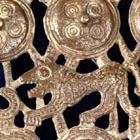J.J. Lally & Co., Oriental Art / New York City, New York
MenuPast Exhibition
Ancient Chinese Bronzes
March 19 - April 9, 2011
22.
AN ARCHAIC BRONZE OPENWORK ORNAMENTAL PLAQUE
Eastern Zhou Dynasty (770 – 256 B.C.)
of trapezoidal shape with concave lateral flanks flaring towards the top, framed by a continuous border of round bosses, and with a slightly tapered pin emerging from a stylized animal head at the center of the flat base, the openwork panel decorated in shallow relief on one side with four rows of different animals separated by rows of bosses; the uppermost row with eleven slender long-horned sheep or antelope running from left to right above a band of small bosses; the second row cast with five bovine beasts with hooked horns, shaggy bodies and long bushy tails walking from left to right above a band of five larger bosses each decorated with intaglio whirl motifs around a central nipple; the third row with three long-tailed feline beasts, with beaded and striped designs on their sides, pacing from right to left above a row of five plain bosses surrounded by multiple concentric rings, the bottom row with four serpents with pointed heads, their flattened bodies decorated with beaded ‘scales’, arranged in pairs and oriented to the center; the decoration all conjoined by numerous short struts, the reverse plain and with a pair of small loops for attachment, with smooth reddish-brown patina overall.
Width 5 1⁄2 inches (14 cm)
Length 5 7⁄8 inches (15 cm)
Compare the similar bronze openwork plaque unearthed in the Aba Tibetan and Qiang Autonomous District of Western Sichuan province at Moutuo village, Maoxian, illustrated in color on the cover of Wenwu, 1994, No. 3, and in a line drawing on p. 30; illustrated again in Zhongguo qingtongqi quanji: Bashu (Compendium of Chinese Bronzes: Sichuan), Vol. 13, Beijing, 1994, pl. 65. The Moutuo excavation was a single tomb or cenotaph and three caches, all apparently buried within a short time span, found to contain more than 100 bronze objects of widely different types, styles, and geographical origins.
The Moutuo plaque is discussed at length by von Falkenhausen in an article entitled “The Moutuo Bronzes: New Perspectives on the late Bronze Age in Sichuan,” published in Arts Asiatiques, tome 51, 1996, pp. 29-59, where the group of bronzes found at the site is described as “…the most startlingly heterogenous archaeological assemblage [excavated] in East Asia to-date” and the plaque is referred to as “…easily the most enigmatic object in the Moutuo assemblage…” In the course of discussion, von Falkenhausen points out that “The intricate openwork animal decoration of the Moutuo ‘plaque ornament’ might ... suggest connections with the Dian culture.” He further notes that “similarities to northerly areas—the Zhou cultural area as well as the Eurasian Steppes should also be noted.” In summarizing his thoughts about the Moutuo plaque, von Falkenhausen proposes that “stylistically and iconographically, the Moutuo ‘plaque ornament’ seems, thus, to constitute a bridge between the bronze-casting tradition of the Eurasian Steppes and Southeast Asia (including Dian).”
東周 動物紋鏤空銅牌飾
寬 14 厘米
長 14.7 厘米
